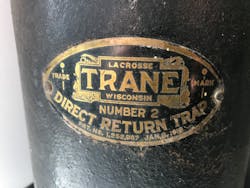There was a problem in the early days of two pipe steam heating. All the steam boilers back then were coal- or wood-fired, just like the steam locomotives of the day. A roaring fire needed to be built by hand in order to change the water to steam. That steam would then distribute through the system of radiation to heat the building. As steam would hit the cold radiators, it would condense back to water and start to flow downhill, like water is supposed to.
It is then supposed to go back into the boiler so it can turn back into steam and keep the cycle going. However, with the roaring fire comes increased pressure. Water can flow downhill to the basement, but it then encounters one of those laws of physics that we can’t always see, but inherently understand. Lower pressure doesn’t move to higher pressure. It’s the other way around.
The train engineers figured out the problem early on and had their own mechanism, called an injector. They were operating the steam boilers on their locomotives at hundreds of pounds of pressure and needing to maintain the waterline by refilling out of a tender that was at atmospheric pressure. The injector used whatever steam pressure the boiler was operating at to push the water back into the boiler.
We aren’t train engineers, so we work with much lower pressures. Our law of physics is 28” of vertical height above the waterline equals one pound of pressure. That means if the boiler is operating at one pound of pressure, water stacks up above the waterline in the dry return of a two-pipe system to a height of 28” before the water starts sliding back into the boiler. Two pounds of pressure equals 56”. Much higher and the water starts backing up into the horizontal mains, where it’s not supposed to be, causing problems like spitting vents and uneven heat.
A roaring fire that is quickly building up pressure is not easily slowed down. Fire control was down with the draft doors. Less air equals less fire which equals less pressure, but the regulators used back then weren’t necessarily reactive enough. A device like a steam injector was needed. The industry stepped up to the challenge with multiple products, with names like “equalizing loop”, “boiler return trap”, “differential loop”, “direct return trap”, and “alternating receiver”.
They all performed the same function of pushing the water back into the boiler by using the steam pressure of the boiler. Some were mechanical with floats and valves, while others were non-mechanical with no moving parts. Somehow, they all claimed to be a better system than the competition, (some things never change).
A good customer in Dayton, Ohio called to ask if it was necessary to keep this in the system during the new gas boiler install they were working on. I told him it served no real function anymore and the common advice of the industry is to remove it. He said it had a nice brass tag on it and asked if I wanted it, since he knows I have a collection of steam components. Yes, the date is 1918.
The smaller ones I use for show-and-tell during classes. It keeps the techs awake making them pass things around the classroom, one of the tricks of the teaching trade. I knew I already had this particular model, but like any collector, I want more. Mine has the gauge glass option so you could see the water level in the return trap, but no tag, just a model number and patent date in cast iron. Yes, that is the same Trane Company that we know today. They used to be big in the steam business.
Today, with our automatically fired gas- or oil-burners, the pressure is controlled by shutting off the burner with an operating or high limit pressure control. As the pressure rises, the control opens the burner electrical circuit to shut off the fuel. With no combustion, the boiler’s pressure starts to fall as the steam moves into the piping. No need for using the steam pressure to push the water back into the boiler. Let the stacking effect of the return water push the water back in.
The problem with coal fired boilers was the residual heat, even after the draft doors cut off the air. The coal kept burning, keeping the pressure rising. To combat that, the devices of the olden days kept the water level of the boiler where it should be to prevent dry fire accidents from low water conditions while keeping the water out of the mains. With automatic fired boilers, both conditions are controlled electrically.
Back in 1918, electricity and gas in the home were just starting to become commonplace. In ten years, both were common and used for steam heating. These devices were basically obsolete soon after they were essential. When you find them in a system today, pause to respect the job they did years ago, then retire them to an appreciative collector.
For a more detailed explanation of boiler return traps, check out page 100-101 of my field guide, available as a free download at steamupairoutwaterback.com.
Next month, per the Kid’s request, since it’s his birthday, I’ll discuss the risks and rewards of converting a steam system to high efficiency hot water. Be safe out there.
Patrick Linhardt is a thirty-seven-year veteran of the wholesale side of the hydronic industry who has been designing and troubleshooting steam and hot water heating systems, pumps and controls on an almost daily basis. An educator and author, he is currently Hydronic Manager at the Corken Steel Products Co.
About the Author
Patrick Linhardt
Patrick Linhardt is a forty-one-year veteran of the wholesale side of the hydronic industry who has been designing and troubleshooting steam and hot water heating systems, pumps and controls on an almost daily basis. An educator and author, he is currently Hydronic Manager at the Corken Steel Products Co.

